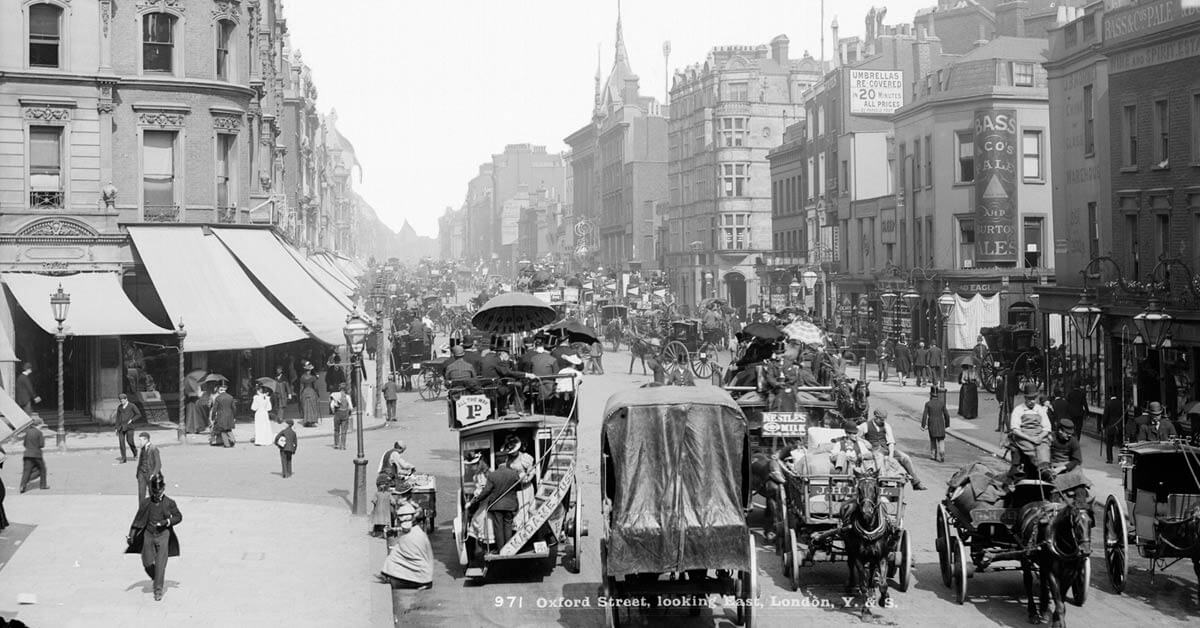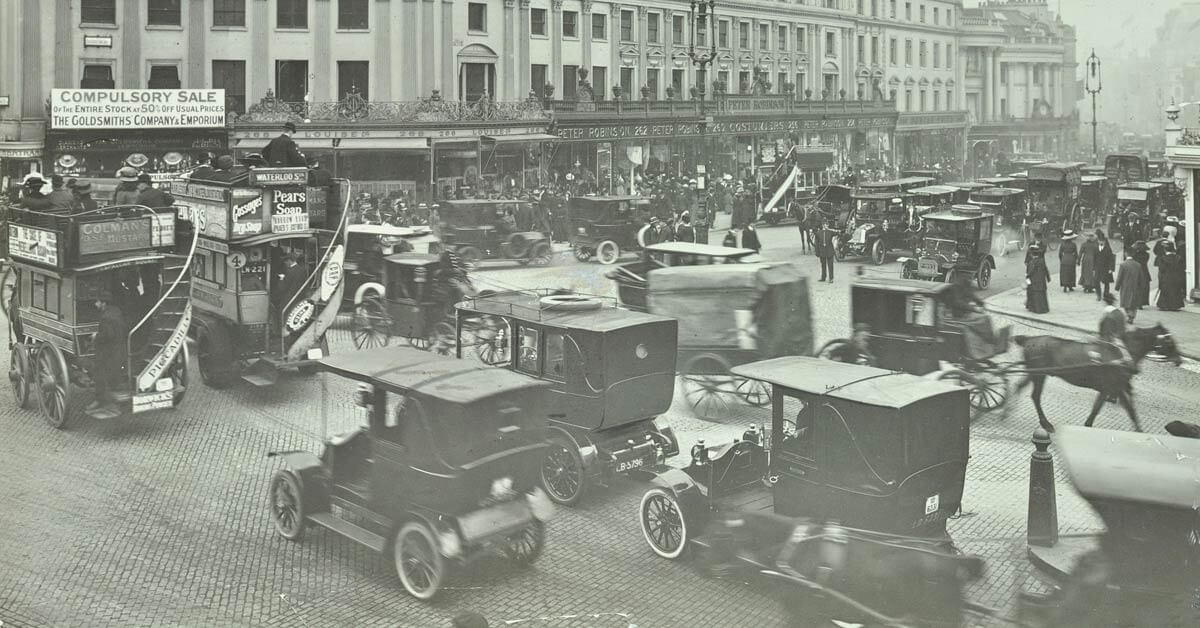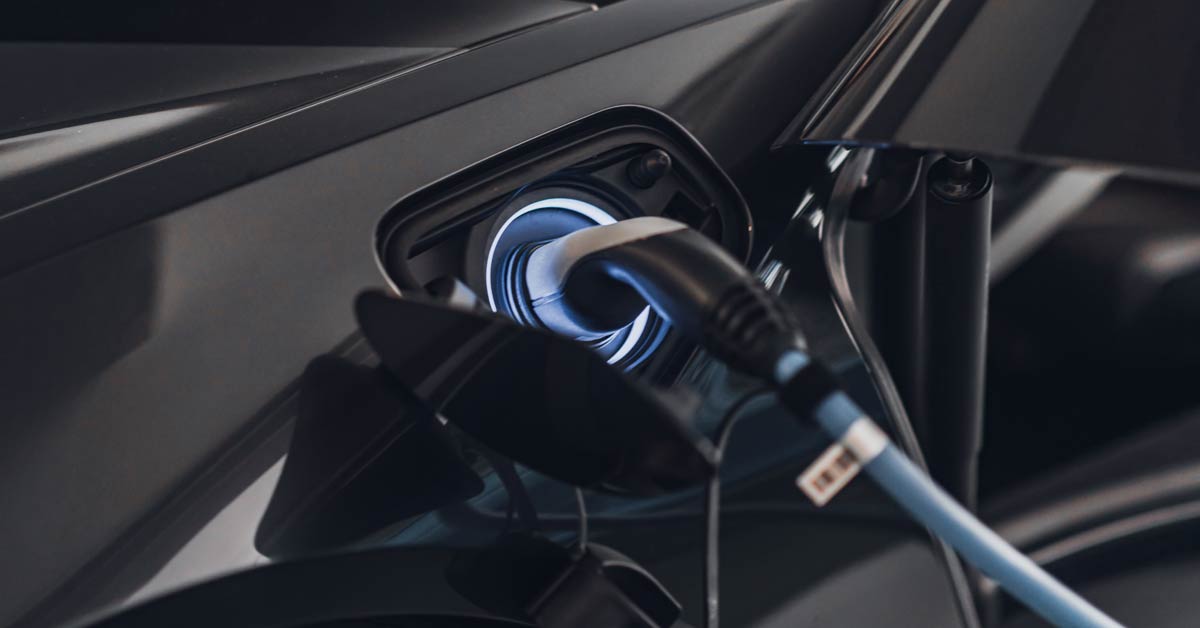In my second blog instalment relating to electric cars I thought I might consider how the future might look. Before I do however let’s look back in time to 1900 or thereabouts. London, Oxford Street looked something like this;

And in 1910, something like this;

You will quickly notice that in the space of only 10 years we changed from a largely horse-drawn transportation system to one using primarily cars. Well in London anyway. Just give a little thought to how the world must have changed for all that to happen; in 10 years the horses, blacksmiths, stables, feed suppliers, cart manufacturers, wheelwrights, Vets (the list goes on) all disappeared to be replaced by the car and all of its infrastructure. It may have taken longer in the countryside, but it still happened.
‘So what?’, I hear you say. Well, I believe that we are currently on the cusp of a new transportation revolution ourselves. Let me try to explain my thinking;
Powering the new revolution
As I said before in my first blog, electric cars are inherently simple devices with few moving parts and require little maintenance. They are cheap to manufacture (excluding the battery) lightweight and require very little heavy infrastructure to support them.
Battery technology is constantly improving and the range available on a single charge to an electric car increases almost daily. However, it is very important to note that batteries are not the only way to power an electric car. Fuel Cells, for example, take Hydrogen and Oxygen and produce electricity directly. Not only are these devices solid state they are very efficient with some types offering efficiencies upwards of 85% and power outputs in excess of 200KW. Electric cars do not have to put a strain on the National grid or wait for the next generation of nuclear power stations to be built.
Driverless vehicles, surely not!
We have all heard about autonomous vehicles; vehicles that drive themselves. Well, we are a little way off yet but give it 5 or 10 years and they are almost certain to be commonplace. We will be able to call our travel service via our smart app and our carriage will arrive all by itself and take us wherever we want, much as they do today. The difference will be that these carriages will probably be electric, probably autonomous and certainly operating as a ‘smart fleet’. If one car breaks down or requires refueling it simply ‘calls’ another car to take over the journey. Remember these cars are simple devices which should reduce the requirement for regular maintenance, improve safety and be cheap to run. Call a cab and for a short journey, it might cost £1 not £10.
Now, if we presume that people take to the idea and like it as they did when cars first took over from the horse-drawn carriage, we can surmise that the requirement to own a car will also diminish. Certainly, in the city centres. If you need a car, call one, and let’s face it with Uber and similar that is exactly what we do now. The difference will be cost; pay on demand autonomous electric vehicles could reduce the cost down to less than 10% of owning and running your own car.
And flexible working as well!
Over the past 10-20 years we have seen people’s work patterns changing quite considerably and with the introduction of flexible working practices, it has allowed us to travel around in a more efficient manner. We no longer need to travel during the rush hour unless we either want to or absolutely have to. If the rush hour can be widened by staggering start times, then a fleet of suitably controlled vehicles could better support the needs of many individuals. We do not need one car per person anymore but maybe one car per 10 or 15 or maybe more. This means the rush hour(s) become less busy, arrival times easier to predict and fewer cars on the road.
Moving people over to this newer form of transportation means that some may not need to use the trains for the more local journey and even the demands on buses could reduce especially as costs reduce. All of this helps in reducing the need for publicly funded infrastructure. It can also mean that simple effective and high-quality transportation becomes within the grasp of all, not just the rich.
Since most cars are parked for 95% of the time, we can save a huge amount of valuable space by simply not needing to park cars in the first place. There are roughly 40 Million cars in the UK and as you read this the majority will almost certainly be parked. That equates to about 300 km2 of wasted space or 100 times the area of the City of London.
But pull it all together...
By traveling more efficiently, sharing the vehicles we use and changing our thinking away from owning vehicles to hiring a vehicle we can reduce the number of cars on the road, reduce congestion, reduce emissions and make roadways safer. Indeed, we could see many inner-city roads returned to pedestrianised areas for use by the community rather than just acting as car parks.
So, by combining the benefits of electric vehicles with autonomous navigation, smart fleets and flexible working we have an opportunity to reduce the number of cars on the road, reduce congestion, reduce emissions, make the daily commute more pleasurable, improve safety and save money.
All of this will require a mindset change from us all; not dissimilar to one we saw between 1900 and 1910. However none of this impossible to achieve in the next 10 years and like it or not, some things will be with us much sooner.
Now, where’s my cab?...
Managing Director
Paul is the founder and Managing Director of Optima Systems which he set up in 1990. His role today has changed considerably since those early days and now he spends much of his time on the road talking to new potential clients and spreading the word. Paul visits the USA on a regular basis as well as travelling around the UK particularly now that Optima has moved away from primarily financial software into the realms of clinical data and medical research. More about Paul.
Ask Paul about Software Solution / APL / APL Consultancy / APL Legacy System Support

